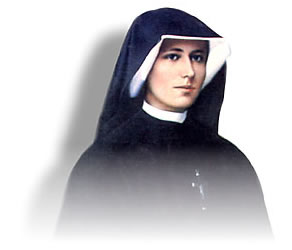St. Faustina
She was born on August 25, 1905 in Glogowiec in Poland of a poor and religious family of peasants, the third of ten children. She was baptized with the name Helena. Called during a vision of the Suffering Christ, on August 1, 1925 she entered the Congregation of the Sisters of Our Lady of Mercy and took the name Sister Maria Faustina. The years she had spent at the convent were filled with extraordinary gifts, such as: revelations, visions, hidden stigmata, participation in the Passion of the Lord, the gift of bilocation, the reading of human souls, the gift of prophecy, or the rare gift of mystical engagement and marriage. The living relationship with God, the Blessed Mother, the Angels, the Saints, the souls in Purgatory — with the entire supernatural world — was as equally real for her as was the world she perceived with her senses.Sister Maria Faustina, consumed by tuberculosis and by innumerable sufferings which she accepted as a voluntary sacrifice for sinners, died in Krakow at the age of just thirty three on October 5, 1938 with a reputation for spiritual maturity and a mystical union with God.
On April 18, 1993 our Holy Father John Paul II raised Sister Faustina to the honors of the altar. St. Maria Faustina’s remains rest at the Sanctuary of the Divine Mercy in Kraków-ºagiewniki.
The mission of St. Faustina consists in 3 tasks: (She accomplished this through help of her confessor)
- Reminding the world of the truth of our faith revealed in the Holy Scripture about the merciful love of God toward every human being. (brought out in her diary)
- Entreating God’s mercy for the whole world and particularly for sinners, among others through the practice of new forms of devotion to the Divine Mercy presented by the Lord Jesus, such as: the veneration of the image of the Divine Mercy with the inscription: Jesus, I Trust in You, the feast of the Divine Mercy celebrated on the first Sunday after Easter, chaplet to the Divine Mercy and prayer at the Hour of Mercy (3p.m.). The Lord Jesus attached great promises to the above forms of devotion, provided one entrusted one’s life to God and practiced active love of one’s neighbor. ( Physically done by her confessor but brought about by her through Jesus)
- The third task in St. Maria Faustina’s mission consists in initiating the apostolic movement of the Divine Mercy which undertakes the task of proclaiming and entreating God’s mercy for the world and Strives for Christian perfection, following the precepts laid down by Saint Maria Faustina. The precepts in question require the faithful to display an attitude of child-like trust in God which expresses itself in fulfilling His will, as well as in the attitude of mercy toward one’s neighbors. Today, this movement within the Church involves millions of people throughout the world; it comprises religious congregations, lay institutes, religious, brotherhoods, associations, various communities of apostles of the Divine Mercy, as well as individual people who take up the tasks which the Lord Jesus communicated to them through St. Maria Faustina. (Physically done by her confessor but brought about by her through Jesus)





.jpg)

You must log in to post a comment.